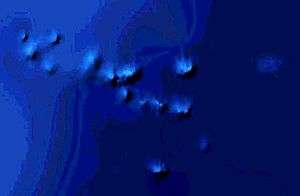Newfoundland Seamounts
| Newfoundland Seamounts | |
|---|---|
|
Aerial image of the Newfoundland Seamounts | |
| Location | |
| Location | North Atlantic Ocean |
| Country | Canada |
| Geology | |
| Age of rock | Cretaceous |
| Last eruption | Cretaceous |
The Newfoundland Seamounts are a group of seamounts offshore of Eastern Canada in the northern Atlantic Ocean. Named for the island of Newfoundland, this group of seamounts formed during the Cretaceous period and are poorly studied.[1]
The Newfoundland Seamounts appear to have formed as a result of the North American Plate passing over the Azores hotspot. Scruncheon Seamount in the middle of the chain has given an isotopic date of 97.7 ± 1.5 million years for the Newfoundland Seamounts. This indicates that the Newfoundland Seamounts were volcanically active in the earliest Cenomanian stage.[2]
Seamounts
The Newfoundland Seamounts include:
- Shredder Seamount
- Scruncheon Seamount
See also
References
- ↑ Paleocene volcanic sand provenance
- ↑ Roberts, David G.; Bally, A.W. (2012). Regional Geology and Tectonics: Phanerozoic Passive Margins, Cratonic Basins and Global Tectonic Maps. Elsevier. p. 357. ISBN 978-0-444-56357-6.
Coordinates: 43°41′27.9″N 45°24′15″W / 43.691083°N 45.40417°W
This article is issued from Wikipedia - version of the 1/10/2013. The text is available under the Creative Commons Attribution/Share Alike but additional terms may apply for the media files.
